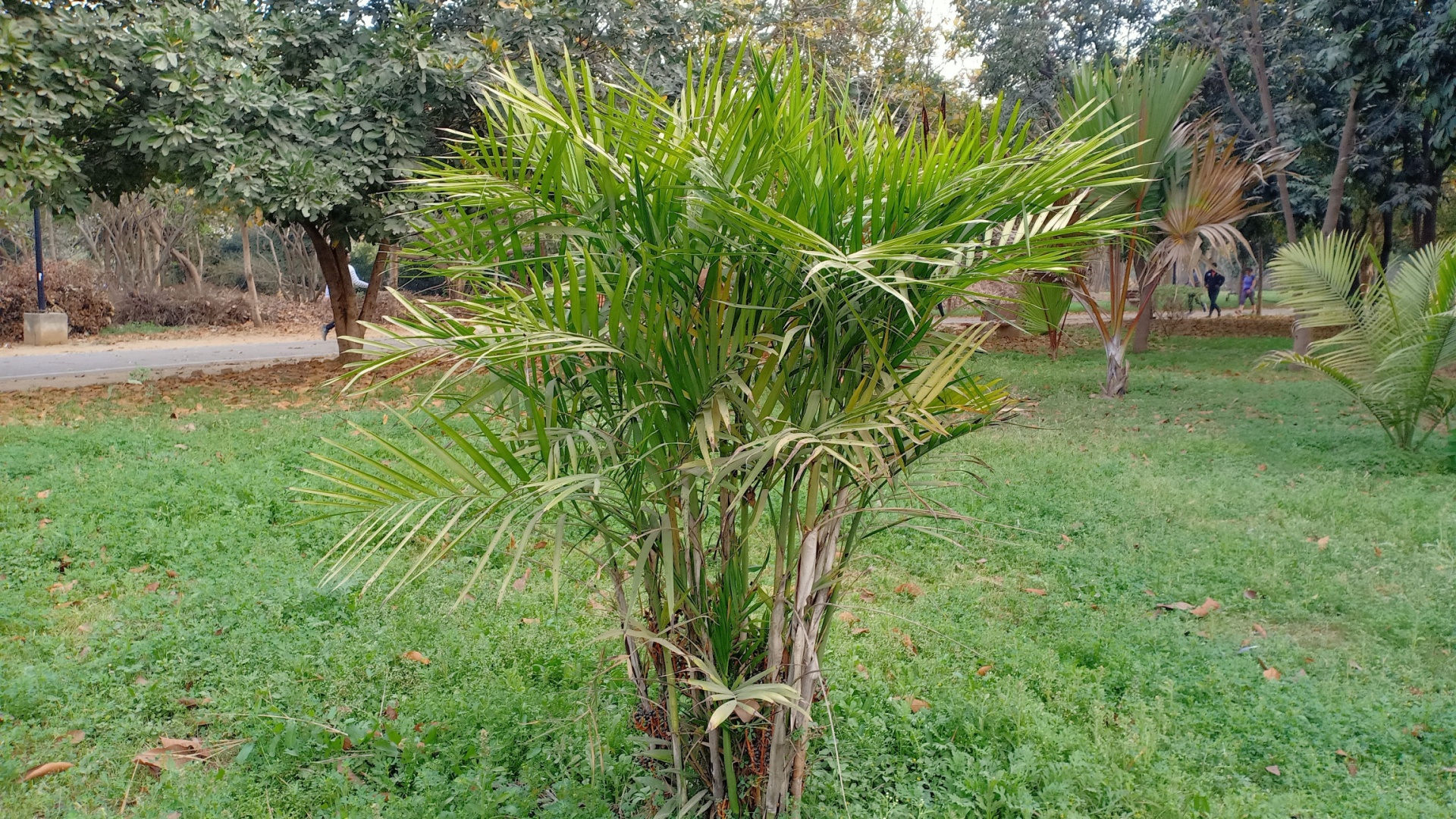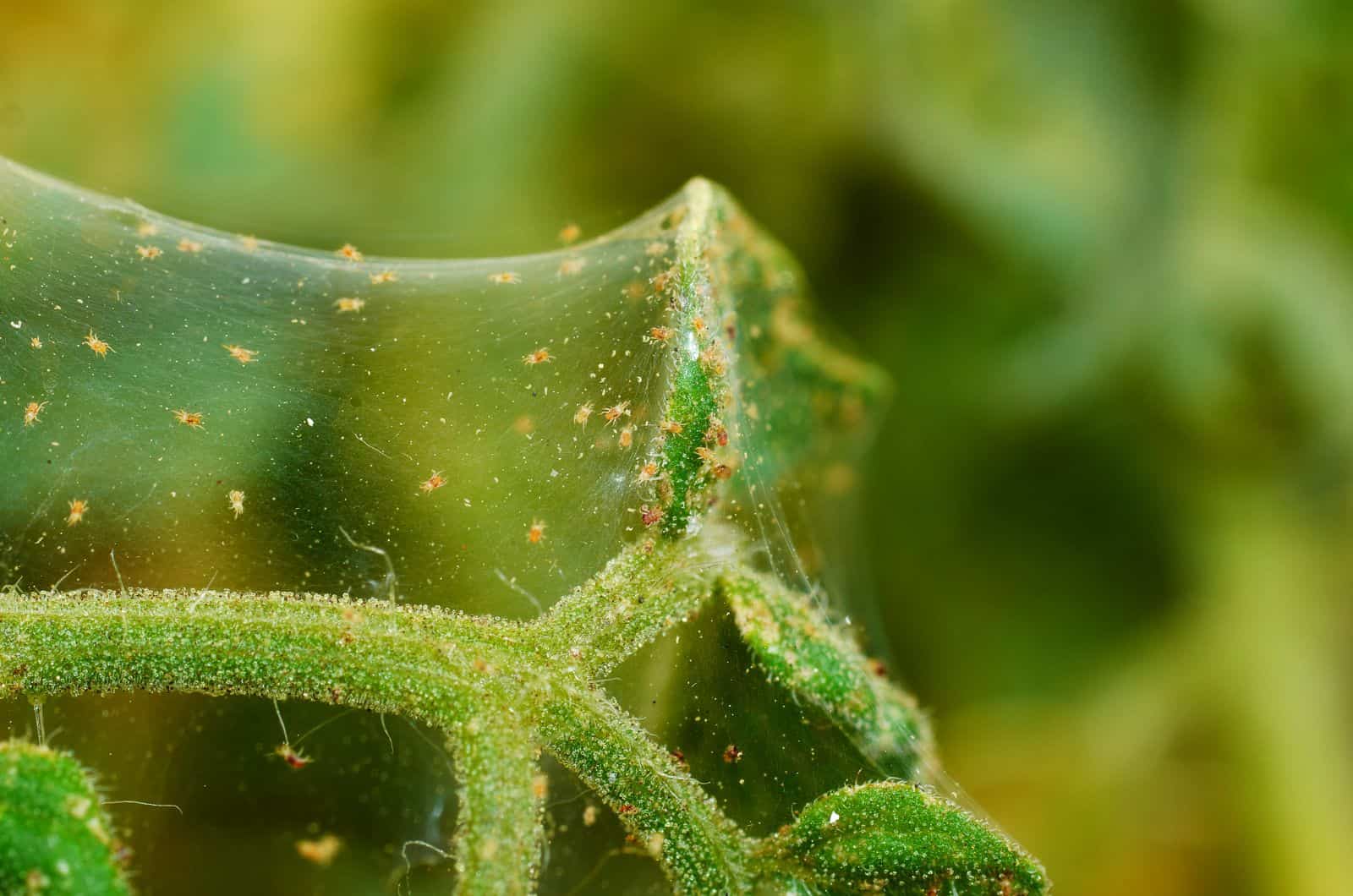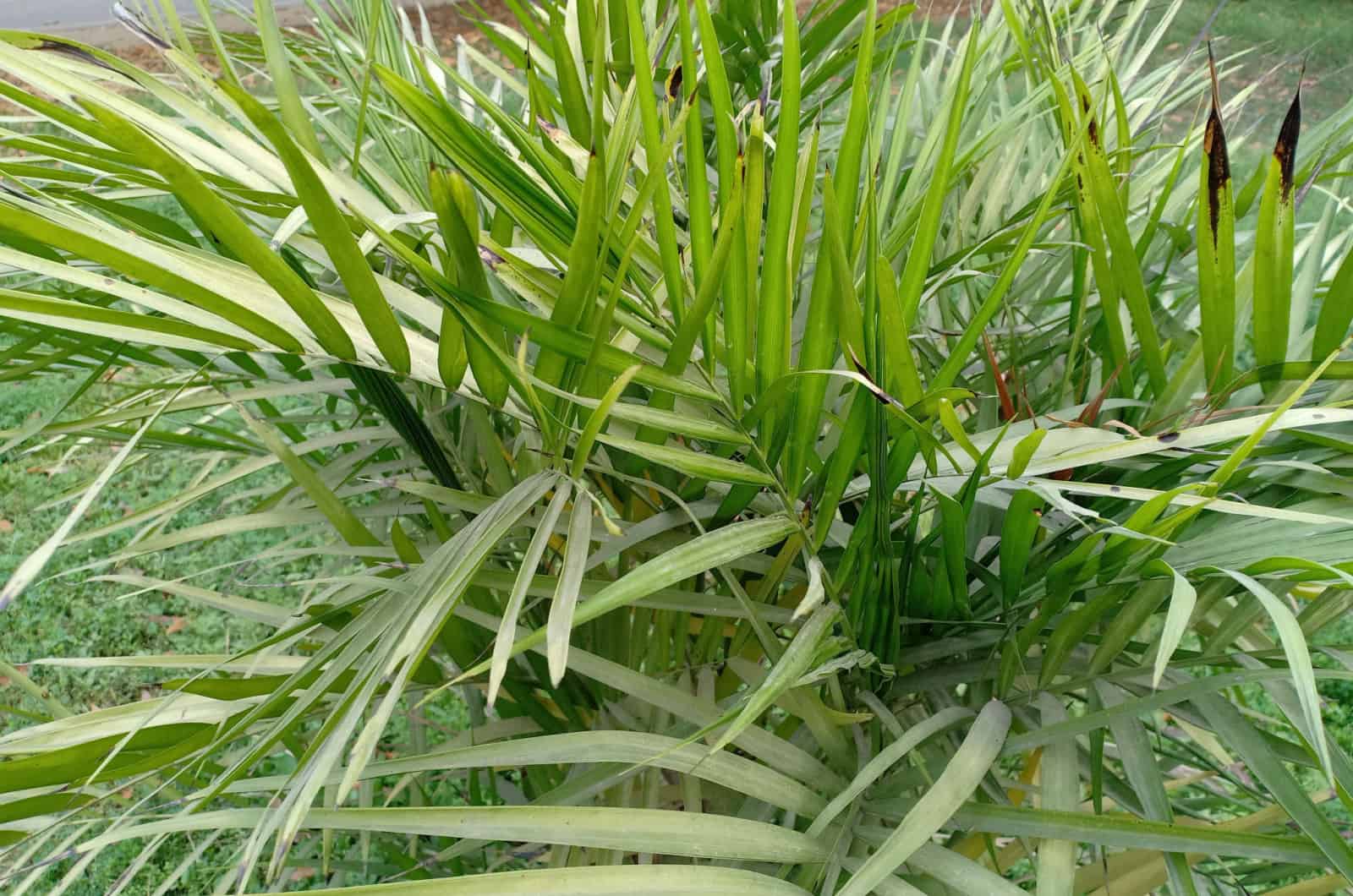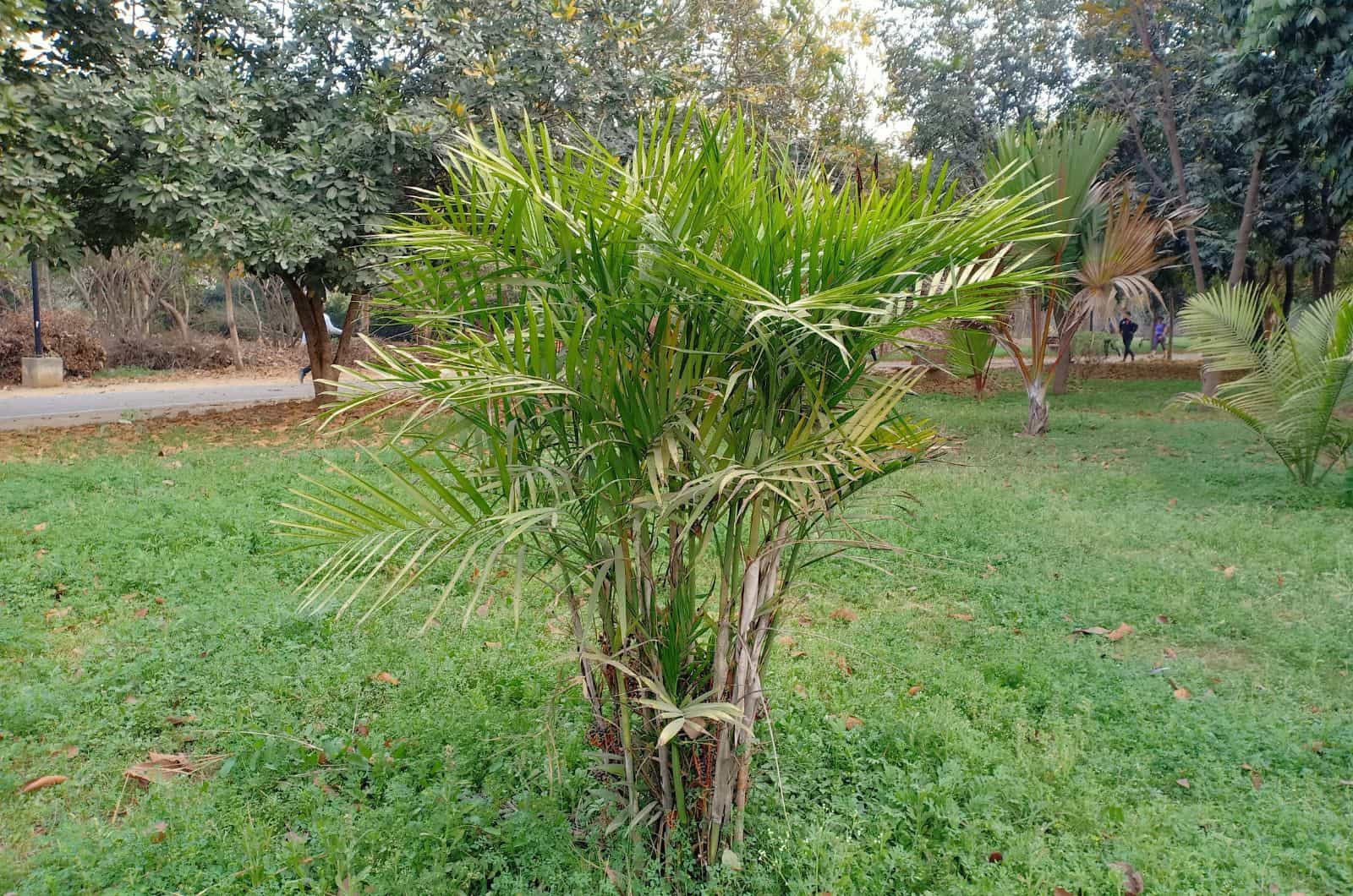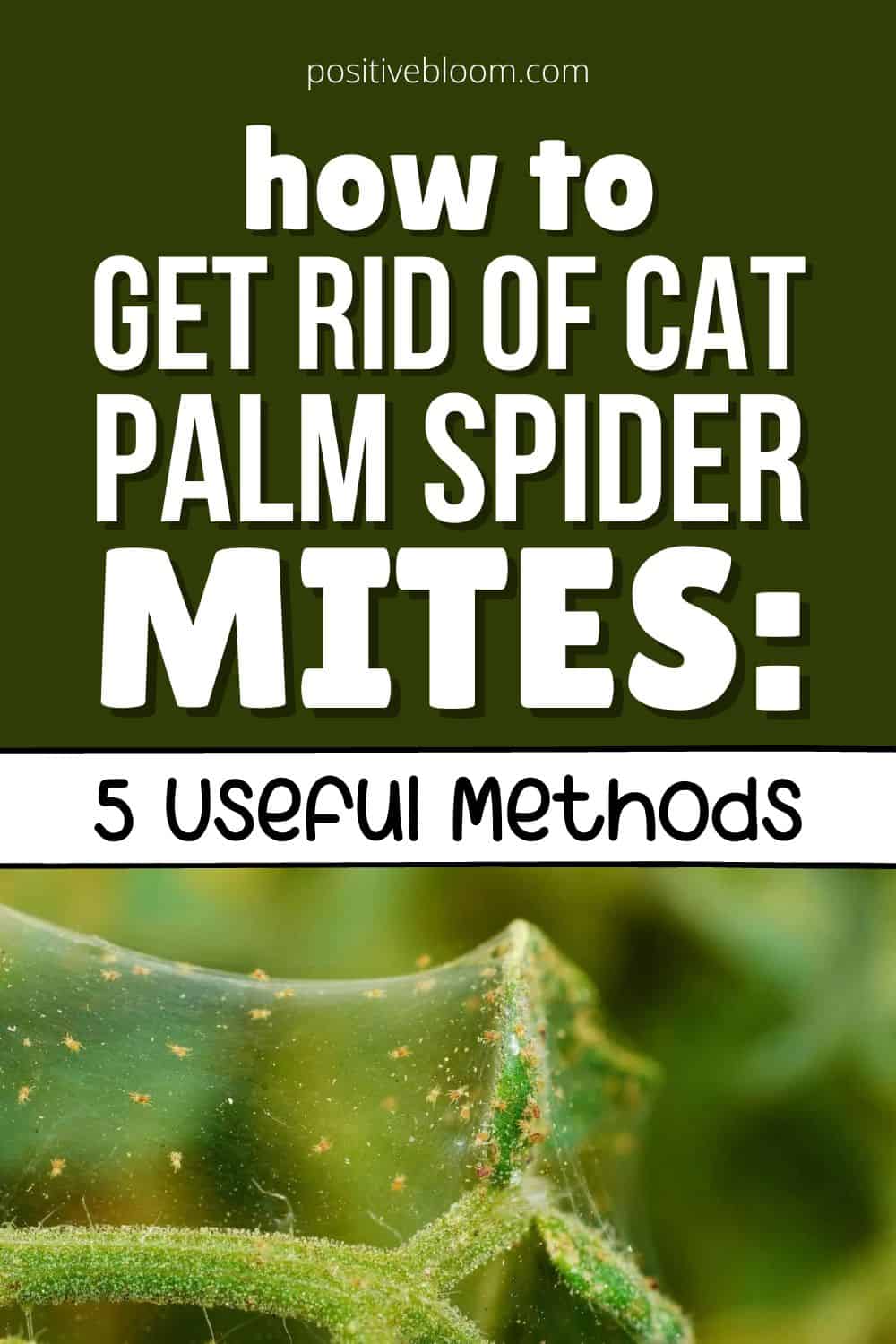The Cat palm is all about the leaves! Seriously, this one-of-a-kind plant is all leaves and no trunk, and you know what else is also all about leaves?
If you guessed spider mites, you are correct!
These little pests start their invasion by settling on the underside of the leaves, where they munch on them before spreading to the entire plant. In the case of this plant, it would be completely destroyed because this palm tree does not have a trunk.
Luckily, a spider mite infestation can easily be treated, and you will be able to nurture those pretty palm leaves back to health relatively easily.
If you are dealing with a Cat palm spider mites infestation, keep reading to find loads of tips and tricks to help you get rid of these pests!
What Are Cat Palm Spider Mites?
These trunkless palms have tightly packed, glossy, dark green, pinnate leaves that can be utilized to fill gaps in your garden, and are occasionally cultivated as hedges.
They are also a great non-toxic decorative houseplant, so you won’t have to worry if your kids or pets eat it accidentally. However, you should start worrying if spider mites start eating the beautiful and juicy fronds!
Please note that this palm plant has many nicknames, such as Cataract palm, Cat palm tree, Cascade palm, Chamaedorea Cataractarum, and Chamaedorea Atrovirens (we will stick with the name Cat palm throughout the article).
The Cat palms are easy to grow and take care of, and with their special tropical appearance, these indoor plants can make any room look more lively!
However, even though we are talking mostly about indoor palm plants, they can grow perfectly fine in an outdoor garden.
These sap-sucking pests can infest both indoor and outdoor plants — in fact, they are very picky about their environment because they prefer growing in dry and hot climates, which is why spider mite infestations are mostly found in greenhouse plants.
What Do Cat Palm Spider Mites Look Like?
Adult spider mites have four pairs of legs, for a total of eight legs. They also have a mouth with two chelicerae, or fangs, which they use to eat into plant cells. The color of their bodies will vary depending on what they eat.
Although their legs may be a lighter shade of brown, they typically have a light brown, dark brown, or even black appearance. Other varieties come in a range of colors, including pink, green, and yellow.
Young spider mites have oval bodies that range in color from brown to reddish, but they are much smaller.
The majority of the time, mites live in colonies on the underside of leaves, where they feed by piercing leaf tissue and sucking up plant juices. There will be light patches that resemble feeding marks on the leaves.
The obvious symptoms of a spider mite infestation include the leaves becoming yellow, drying out, and eventually falling off. Tiny webs may also start to emerge all over the plant.
In fact, because the spider mites create webs that cover the leaves in fine silk that collects dust and has a muddy appearance, the plant as a whole may eventually degenerate.
What Do Cat Palm Spider Mites Eat?
Due to the extensive distribution of these tiny animals, scientists have found that spider mites consume over 300 different plant species.
Spider mites, as we’ve already mentioned, frequently gather on the underside of leaves, where they pierce the plant’s cells and tissues and ingest the juice that leaks out. Nutrients, including nitrogenous chemicals and inorganic salts, are present in this sap and are advantageous to these small pests.
Even the chlorophyll in the leaves is consumed!
They will gradually spread to the entire plant after making tiny holes in it one by one.
Where Do Cat Palm Spider Mites Live?
These pests live on a cat palm plant! Spider mites are particularly common in hot, dry conditions, especially when their natural predators have been removed because of the use of insecticides. Most of these plant-feeding mites are eaten by numerous species prevalent in North America.
Some predatory mites can be found in humid places as well, even though they prefer dry environments. Nevertheless, when they are found in areas with high humidity, their fertility rate and the likelihood that the eggs will hatch both drastically decline.
The reason you should change pesticides if you are dealing with an infested plant for a longer period of time is because spider mites can easily adapt to the pesticide or miticide that you are using when growing and reproducing in ideal conditions (for example, in temperature around 80 degrees Fahrenheit).
They frequently invade green plants and trees, typically in areas with higher concentrations of phosphorus, nitrogen, and carbohydrates.
Because of their profusion and high population density, serious infestations frequently form undetected before plants show any signs damage or distress.
In hydroponic gardens, greenhouses, and commercial fields with drip watering systems that don’t regularly wash them from the underside of the leaves, spider mites can be seen establishing their colonies indoors.
Large spider mite populations typically go hand in hand with fine webbing. Among the many host plants that typically experience damage from spider mites are strawberries, melons, beans, tomatoes, eggplant, beautiful flowers, trees, and the majority of houseplants.
The Most Common Spider Mites Varieties
The Spruce spider mite and Two-spotted spider mites are the most common spider varieties that infest indoor and outdoor plants.
Let’s learn a thing or two to help you differentiate between them (even though you can’t exactly see them with your eyes, you can always use a magnifying glass to help you determine the species).
Spruce Spider Mite
The Spruce Spider Mite, sometimes known as the “cool-season” mite, is distinct from the other mite species because it prefers a variety of conifers, including arborvitae, pines, spruces, and junipers.
These mites adhere to small branches where they spend the winter in the egg stage before hatching in March or April. The female Spruce spider mite will hibernate and lay eggs in the soil if the summer temperature is higher than 86 degrees Fahrenheit.
When the weather begins to cool off in the fall, these eggs will begin to hatch.
Conifers usually react slowly to the feeding of this mite. Even though the damage may have occurred the previous fall and spring, it may take until the temperatures start to rise for the yellowing and bronzing of the needles to become apparent.
Two-spotted Spider Mite
Over 180 plants, including weeds, houseplants, ornamental plants, and field crops, have been identified as hosts for Two-spotted spider mites, commonly known as “warm-season” mites.
Female Two-spotted spider mites spend the winter months settling in the soil before becoming active in April and May, which is when they begin to infest the plant. As spider mites spend so much time in the dirt, you can frequently find their eggs there.
The females can lay about 20 eggs per day, and it only takes around 20 days to raise an entire generation of these tiny creatures, just like typical spider mites. But if the humidity and temperature are just right, it can take even less time.
What Are The Signs Of Spider Mites Infestation?
If there is anything wrong with your Cat palm plant, you will know because a spider mite infestation is primarily manifested on the leaves — and this plant consists solely of majestic palm fronds.
It does not necessarily mean that yellow and brown leaves have appeared because of a spider mite infestation; there are other common issues such as overwatering your palm plants as well.
The most common signs of spider mite infestation include:
• Leaves start fading
• Yellow and brown leaves
• Brown leaf tips
• Plant is not vibrant
• Sandy texture on the leaves
• Tiny webs all over the plant
It’s such a shame to lose any plant to houseplant pests and diseases (Mealybugs nearly destroyed my Majesty palm!). If you notice any of these signs, the most important thing is to act immediately and start treating your beloved plant.
Mild infestations can easily be treated so you don’t have to buy a new plant. In cases of severe infestation, you can always try propagation.
How To Get Rid Of Cat Palm Spider Mites
As I mentioned above, the most important thing is to act quickly so you can control and prevent the further spread of these little devils.
Luckily, there are tons of options that you can use to get rid of spider mites!
If you prefer organic methods, there are several natural remedies that you can use. However, pesticides and insecticides will also do the trick.
1. Insecticidal Soap
Pesticides might harm plants, so they’re best avoided. Sometimes chemical solutions are required, and in this case I suggest using insecticides created especially for spider mites. They pose no threat to your plant or the soil.
I recommend using an additional solution for eggs and the other stages of the life cycle before adulthood because these are most effective against adult spider mites.
Spray the leaves with a solution made of one liter of warm water and one teaspoon of mild dish soap.
2. Horticultural Oils
According to gardeners and growers, neem oil is excellent for getting rid of spider mites and other pests like fungus gnats, aphids, or thrips.
This natural spider mite control won’t harm your plant or its sensitive roots, while pesticides occasionally do more harm than good.
Spider mites and other pests become confused by neem oil’s toxic ingredient, azadirachtin, and they are unable to consume or reproduce once they come into contact with this substance.
Eggs slowly stop developing into larvae and eventually die. By doing this, you are completely eliminating the colony.
Neem oil works best when used properly, otherwise you risk attracting more spider mites. Neem oil should be used before the plant becomes infested for optimum results. Neem oil serves as a thorough pest deterrent that you should apply twice a month.
Neem oil obtained from agricultural goods is more organic than neem oil used for medicinal purposes, so don’t go to doctors asking for neem oil!
Always moisten the plant and the surrounding soil before applying neem oil.
You can combine 1 teaspoon of insecticidal soap and 1/2 teaspoon of agricultural neem oil in 1 liter of water. The prescribed amounts of substances should never be changed because doing so could cause damage to your plant.
Early morning or late evening are the best times to use spray bottles to spray the mixture on the affected areas. This is because warmer temperatures can warm the oil and burn your plant.
Neem oil is a horticultural oil that can be used as a fungicide and preventative step, and is one of the best houseplant and garden pest controls.
3. Rubbing Alcohol
I use rubbing alcohol to get rid of a variety of bugs, not just spider mites. Despite the fact that the majority of indoor plants aren’t susceptible to probelematic insects, you should still have a plan in place in case pests decide to pay you a visit.
As it is easy to apply and has a high success rate, rubbing alcohol stands out as a potential remedy. Carefully rub the leaves with the rubbing alcohol using a paper towel or cotton bud.
Don’t forget to rub the undersides of the leaves.
Pour 3 parts water and 1 part rubbing alcohol into the soil or use a spray bottle to apply the rubbing alcohol mixture.
4. Imidacloprid
Among the many other widely accessible pesticides, I suggest you use crystalline, granular insecticides that contain imidacloprid. Prior to wetting the crystals with water, apply the pesticide to the polluted soil. This way the crystals will cause the poison to become active.
You can also apply a systemic pesticide, but make sure it has imidacloprid in it. Amazingly, both the soil-dwelling spider eggs and the spider eggs on plant leaves will be affected by this combination.
Spider mites, on the other hand, have the intriguing trait of not remaining on the plant for very long. But if they do, imidacloprid will ensure that it is brief and that they won’t come back!
5. Natural Predators
Because larger animals are always preying on smaller ones in nature, spider mites are likewise vulnerable to natural predators.
The most common predators are ladybugs, lacewings, and predatory mites.
The only drawback is that you need to build the correct habitat in order to attract these beneficial insects. Apply mulch to flower beds instead of using more insecticides because insects detest excess amounts of all three.
Natural predators can also be bought in stores or on Amazon. They are completely safe for both people and animals and can be used on a range of plants.
How To Prevent Spider Mite Infestation
In addition to using neem oil as a preventative measure, the best possible way to prevent a spider mite, or any type of infestation, is by giving your plants the best possible care!
It has been proven that spider mites don’t attack plants that are happy and healthy, which is why you have to make sure you meet the needs of your Cat palm.
Let’s find out more!
Soil Requirements
The Cat palm will flourish in potting soil that drains well, is nutrient-rich, and can hold moisture. Because they are tropical plants, they prefer a somewhat damp soil that is not too wet or too dry.
Loam or sandy soil with good drainage is the ideal soil type. If your soil is too compact, like clay, you can add peat moss or sand to your potting mix to loosen it up a bit.
It’s also important for your plant to grow in a pot that has drainage holes in the bottom, which will help with draining excess water from the soil and prevent overwatering.
Water Requirements
Watering is always challenging with these plants because they prefer to have moist soil all the time. As a result, you can’t adhere to a strict watering schedule; instead, you must wait for your plant to indicate when it needs water.
If two inches of the topsoil are dry, then you should water your palm plant. Otherwise, you should wait a few days before doing so. If you don’t mind getting your hands a little dirty, you can check the soil with either your fingers or a wooden stick.
The type of water you use when watering plants can also cause issues. For example, if your fronds appear somewhat scorched despite not having been exposed to direct sunshine, chemicals in your water, particularly fluoride, may be to blame.
You should use filtered or distilled water instead of tap water, which typically contains hazardous minerals and excessive salt concentrations that can build up in the soil and prevent normal nutrient uptake by the root ball.
Humidity Requirements
We already know that tropical plants absolutely love humidity! Therefore, if you want your Cat palm to have that vibrant and glowing appearance, you should always maintain humidity levels above 50%.
I advise you to buy a humidifier to increase humidity as the majority of homes normally don’t have these levels. You can always mist your plant, just bear in mind that misting should be done every day.
You can also create a pebble tray that will increase the humidity as water evaporates.
Light Requirements
These plants thrive in low light to partial shade. Find a location with bright indirect sunlight if you plan to cultivate the Cat palm inside; your plant would flourish best in south or east-facing windows.
The optimum spot for growing a cat palm outdoors would also be in some shade, though they can stand a little bit of sunlight. Never allow your Cascade palm to be exposed to direct sunlight during the day because the leaves could scorch and moisture would be quickly lost.
Temperature Requirements
Cascade palms don’t mind most temperatures, but they don’t enjoy sudden temperature changes! Your Cascade palm should be kept between 70 and 80 degrees Fahrenheit.
Avoid placing your indoor potted plants next to warm radiators or heating vents, or under air conditioning.
Fertilizer Requirements
Tropical plants normally have enough nutrients in the soil to support healthy growth. However, growers frequently use a nitrogen-rich fertilizer to promote the development of lush foliage and improve the plant’s overall health.
During the spring and summer growing seasons, fertilizer should be applied monthly. During the cooler months, it should be used less often.
Pruning
A Cascade palm will grow densely and develop its own distinctive shape, so you won’t have to worry about trimming to sustain it.
However, in order to stop the spread of an infection, you should remove any dead or damaged leaves using a knife or a pair of pruning shears. Keep in mind that you should only use sterilized gardening tools!
Propagation
If you are dealing with a severe spider mites infestation and it seems like your palm plant can’t be nurtured back to life, I would suggest you try and propagate it.
When it comes to palm trees, propagation is very simple because they produce suckers, which are the side shoots that sprout from the main roots and eventually mature into new plants.
Follow these simple steps to propagate a palm plant:
1. Water your plant the day before propagation.
2. After that, lift the plant and inspect it for suckers. Cut the biggest suckers with the most roots using a clean knife.
3. The dirt in your new pot should be well-draining. Add enough soil to properly cover the roots before inserting your sucker.
4. To preserve moisture and raise the humidity, water it thoroughly and then cover the pot with a plastic sheet. Keep it in an area with bright indirect light.
5. Once your new plant is established, you can take off the plastic sheet and care for it just like you would a mature Cascade palm.
Repotting
You won’t need to worry about repotting cascade palms every growing season because they don’t grow that quickly. If the roots are coming out of the drainage holes, the root ball doesn’t have enough room for growth and development and should be moved to a larger pot. These plants should be repotted once every three years.
Early spring and summer are the best periods to repot Cascade palms so they can have enough time during the growing season to grow and adjust to their new homes!
Purchase a larger pot with drainage holes in the bottom. The best pot material for your little Cat plant would be terracotta or ceramic!
FAQs
1. How do I prevent Spider Mites infesting my palms?
The best way to prevent Spider mites and other annoying pests from infesting your palm plants is by taking proper care of them. Spider mites usually invade the plants that are wilting, damaged, and not thriving.
Proper plant care is one way to go, but you can also apply neem oil as a preventative measure. Neem oil should be applied twice a month, and remember to follow the instructions on the packaging or use the recipe we mentioned before.
2. How do I know if my cat palm has spider mites?
The first sign of spider mites infestation are tiny and silky webs all over the plant. The next obvious sign of spider mite infestation is discoloration on the leaves — brown leaf tips, yellowing, and brown leaves are also indicators that your plant is probably dealing with a spider mite infestation.
In addition to this, they won’t look as vibrant as usual and their color will start fading.
3. What are spider mites?
Spider mites are annoying pests that settle on the undersides of the leaves of both indoor and outdoor plants. These pests poke holes in plant tissue and drink all of the juices to steal your plant’s nutrients!
They are usually found in hot and dry environments and are capable of completely destroying your plants. Luckily, they can easily be treated if you spot the infestation in the early stages.
To Sum Up
Cat palm spider mites can be truly annoying — they cost you money, time, energy, nerves, and most importantly, your plant!
Even though they can be treated, it’s never good to see tiny webs and yellow leaves on your beloved plants, especially if they have been suffering without you even knowing it.
To keep these annoyances away, make sure that you provide your Cat palm plant with the best growing conditions and apply neem oil from time to time just to be safe!
I hope this article was helpful.
Until next time!
Like this post? Share or pin it for later!

